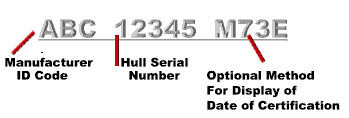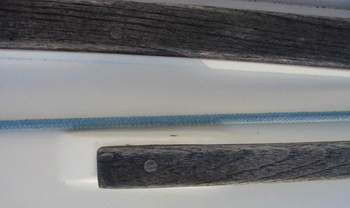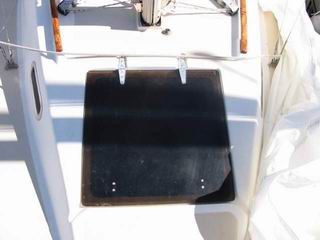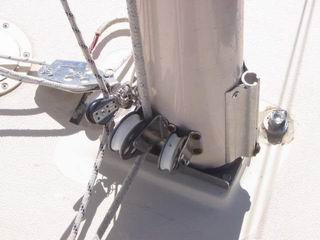| SJ23Tech Tip H08, (Updated 2016-05-15) Chuck Van de Wetering & Bob Schimmel | ||||||||||||||||||||||||||||||||||||||||||||||||||||||||||||||||||||||||||||||||||||||||||||||||||||||||||||||||||||||||||||||||||||||||||||||||||||||||||||||||||||||||||||||||||||||||||||||||||||||||||||||||||||||||||||||||||||||||||||
|
Vintage and Revision of San Juan Sail Boats. |
||||||||||||||||||||||||||||||||||||||||||||||||||||||||||||||||||||||||||||||||||||||||||||||||||||||||||||||||||||||||||||||||||||||||||||||||||||||||||||||||||||||||||||||||||||||||||||||||||||||||||||||||||||||||||||||||||||||||||||
Three companies manufactured San Juan sailboats. Clark Boat Company was the original, followed by Clark Boats. I don't know the name of the last one. DECODING HULL & SAIL NUMBERS - All boats manufactured or imported into the USA on or after November 1, 1972 must bear a 12 character Hull Identification Number (HIN) that uniquely identifies each boat. The HIN has an important safety purpose to enable a manufacturer to clearly identify a boat that is involved in a defect notification and recall campaign. The HIN is not the same as a State (province in Canada) registration number, that must be displayed on the bow of a boat. The HIN is a federal requirement in USA & Canada and a boat registration number is a State or provincial requirement similar to the license plate on a vehicle. The HIN, must be shown on the state or provincial certificate of vessel registration form.
HIN format prior to Aug 1, 1984 - The boat manufacturer must display two identical hull identification numbers, no less than one-fourth of an inch high, on each boat hull. The primary HIN must be permanently affixed (so that it can be seen from outside the boat) to the starboard side of the transom within 2" of the top of the transom, gunwale, or hull/deck joint, whichever is lowest. On a boat without a transom or on a boat where it would be impractical to label the transom, the HIN must be affixed to the starboard outboard side of the hull, within 1' of the stern and within 2" of the top of hull side, gunwale, or hull/deck joint, whichever is lowest. The aft starboard outboard side of the hull is the preferred HIN location for many manufacturers. On a catamaran or pontoon boat the HIN must be affixed on the aft crossbeam within one foot of the starboard hull attachment.
A boat manufactured or imported on or after August 1, 1984, has a secondary HIN affixed somewhere on an unexposed location inside the boat or beneath a fitting or item of hardware. In the case of Joe Fuller (listed in chart below) it was written on the bottom of the starboard cockpit seat. You have to make a dive from the starboard settee to read it. The purpose is to help authorities identify your boat if a thief or vandal removed or damaged the primary HIN on the transom. It is illegal for anyone (manufacturer, dealer, distributor, or owner) to alter or remove a HIN without the express written authorization of the Commandant, U.S. Coast Guard. It must be on the transom if you cross a national border. (I have never found a secondary HIN labelled on Panache. Now that I know how and where it should be located it behoves me not to write it on the wall of the starboard locker.) The regulations prescribing the format of the manufacturer HIN are as follows:
______________________________________________________________________ SJ23 HULL NUMBER - The Hull Identification Number (HIN) of a San Juan 23 is imbedded on the starboard side of the transom. The sail number can be ascertained from the HIN. This same number is on the Registration Certificate or Title issued in most states. Here is the breakdown of a hull identification for boats manufactured after August 1, 1984: MMMhhhhhddyy.
This information came from the U.S. Coast Guard Auxiliary's Boating Skills and Seamanship text, 11th Edition, pages 2-2 and 2-3. ******************************* A typical Clark Boat Company HIN cited to me as an example seems to be a modification of this and reads: CLKJO299M79A
The following are HINs were given to me upon registration by several SJ23 skippers. The year is based on the guideline above.
From the chart above it is certain that the sail number is derived from the hull
number since all owners who submitted
their information have sail numbers that match their hull numbers. However, I would appreciate any
clarification on this from any San Juan owner who knows. |
||||||||||||||||||||||||||||||||||||||||||||||||||||||||||||||||||||||||||||||||||||||||||||||||||||||||||||||||||||||||||||||||||||||||||||||||||||||||||||||||||||||||||||||||||||||||||||||||||||||||||||||||||||||||||||||||||||||||||||
| SJ23 SAIL NUMBER - The hulls sold by Clark were NOT equipped with
numbers on the mainsail. Their sails were only equipped with the SJ23 logo. It costs money to register the sail numbers and
only the subsequent owners of the company registered the ones they
manufactured. The
subsequent manufacturer, Clark Boats, applied both the SJ23 logo and the
sail number to their mainsails. This is yet another way of distinguishing which manufacturer
built your hull, provided you still have the original mainsail! I have no idea what the first or last serial numbers were
that Clark manufactured. NOTE (2016): "For many years
Panache's sail number was 44 which created confusion in resolving
the issue of sail numbers. 44 did not match her HIN and another SJ23 reported the
same number. Then I heard from the previous owner that 44 is actually the year in
which he was born. Really? He needed a sail number to race the
boat so his wife picked his birth year and applied the numbers to the
mainsail. Go figure! |
||||||||||||||||||||||||||||||||||||||||||||||||||||||||||||||||||||||||||||||||||||||||||||||||||||||||||||||||||||||||||||||||||||||||||||||||||||||||||||||||||||||||||||||||||||||||||||||||||||||||||||||||||||||||||||||||||||||||||||
|
OTHER INTERESTING TIDBITS of REVISION INFORMATION |
||||||||||||||||||||||||||||||||||||||||||||||||||||||||||||||||||||||||||||||||||||||||||||||||||||||||||||||||||||||||||||||||||||||||||||||||||||||||||||||||||||||||||||||||||||||||||||||||||||||||||||||||||||||||||||||||||||||||||||
| SAN
JUAN LOGO - The
SJ23 logo has undergone some changes over the years with each new
manufacturer, likely due to copyrights. Note the subtle differences in
font between the two logos below.
|
||||||||||||||||||||||||||||||||||||||||||||||||||||||||||||||||||||||||||||||||||||||||||||||||||||||||||||||||||||||||||||||||||||||||||||||||||||||||||||||||||||||||||||||||||||||||||||||||||||||||||||||||||||||||||||||||||||||||||||
|
|
||||||||||||||||||||||||||||||||||||||||||||||||||||||||||||||||||||||||||||||||||||||||||||||||||||||||||||||||||||||||||||||||||||||||||||||||||||||||||||||||||||||||||||||||||||||||||||||||||||||||||||||||||||||||||||||||||||||||||||
|
HULL PAN - If your boat has the anchor locker in the bow that means it may also have the latest interior fibreglass pan, which has some structural improvements over the original pan. If you lift up the hatch under the V-berth cushion and you see a smooth-finished fibreglass compartment, you have the newer, stronger interior pan. |
||||||||||||||||||||||||||||||||||||||||||||||||||||||||||||||||||||||||||||||||||||||||||||||||||||||||||||||||||||||||||||||||||||||||||||||||||||||||||||||||||||||||||||||||||||||||||||||||||||||||||||||||||||||||||||||||||||||||||||
|
BULKHEADS - Generally made of 1/2" thick marine plywood that has water proof glue between the laminates. Its OK to replace a rotten one with European plywood equipped with 9 plies. Later interiors changed the port bulkhead to half height like the starboard one. |
||||||||||||||||||||||||||||||||||||||||||||||||||||||||||||||||||||||||||||||||||||||||||||||||||||||||||||||||||||||||||||||||||||||||||||||||||||||||||||||||||||||||||||||||||||||||||||||||||||||||||||||||||||||||||||||||||||||||||||
|
Return to Tech Tip Index. . . . . . . . . . . . . . . Have a Question? |
||||||||||||||||||||||||||||||||||||||||||||||||||||||||||||||||||||||||||||||||||||||||||||||||||||||||||||||||||||||||||||||||||||||||||||||||||||||||||||||||||||||||||||||||||||||||||||||||||||||||||||||||||||||||||||||||||||||||||||



 At right is the original logo from Clark. This one belongs to hull 109,
Panache.
At right is the original logo from Clark. This one belongs to hull 109,
Panache. At right is the logo
from Clark Boats, the next generation of hulls. I don't know which boat it belongs to.
At right is the logo
from Clark Boats, the next generation of hulls. I don't know which boat it belongs to.  The
grab rails on the subsequent hulls were mounted with one machine screw
into a metal plate imbedded in each fibreglass stub. Hence
the single wood plug. I have no idea at which serial number this transition was made. If the plate is not corroded, the latter
technique is
definitely the stronger method. Keep this joint well sealed, not grubby like this one!
The
grab rails on the subsequent hulls were mounted with one machine screw
into a metal plate imbedded in each fibreglass stub. Hence
the single wood plug. I have no idea at which serial number this transition was made. If the plate is not corroded, the latter
technique is
definitely the stronger method. Keep this joint well sealed, not grubby like this one! 
